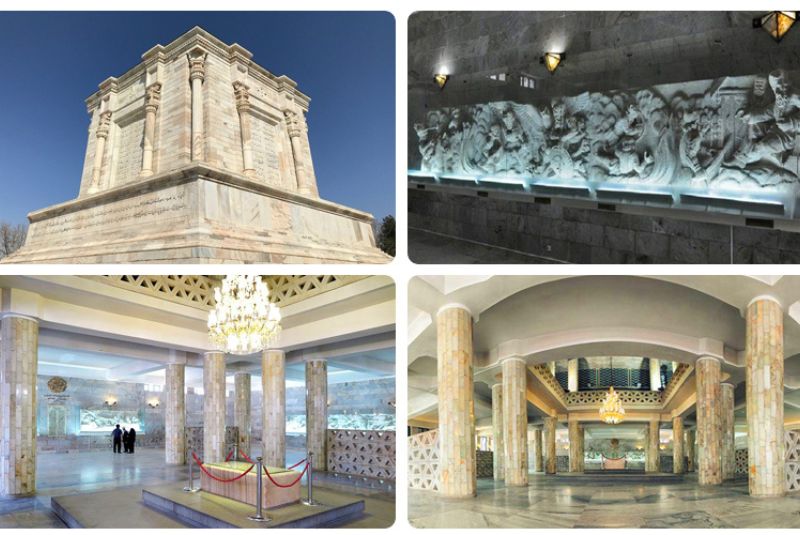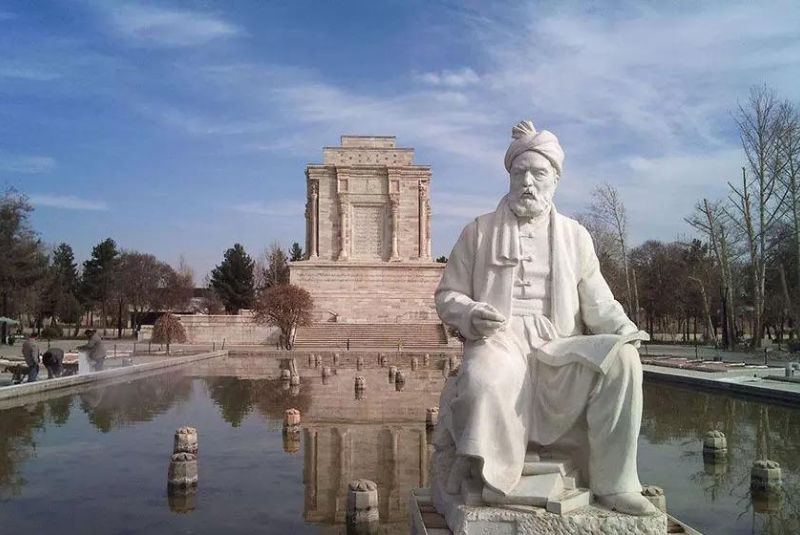Ferdowsi's Mausoleum | Honoring the Poet of the Shahnameh
Towering over the plains of Tus in Iran stands a magnificent monument – Ferdowsi’s Mausoleum.
This remarkable structure serves as a permanent tribute to Abul Qasim Ferdowsi, a legendary figure in Persian literature. Renowned as the "Homer of Persia," Ferdowsi dedicated his life to preserving Iranian history and mythology.
Interested in visiting Ferdowsi's Mausoleum?
Check out our Mashhad tour packages to find an itinerary that includes visiting the Mausoleum
or...
Design your own tailor-made itinerary and include Ferdowsi's Mausoleum in it by yourself, today!
Who Was Ferdowsi?

Ferdowsi (c. 940 AD – c. 1020 AD) was not just a poet; he was a towering figure who shaped the very essence of Persian literature. Born in the village of Paj near Tus, in present-day Iran, Ferdowsi dedicated a monumental 35 years of his life to crafting the Shahnameh (The Book of Kings). This epic masterpiece, containing over 50,000 couplets, transcends mere poetry. It's a cornerstone of Persian culture, a testament to Ferdowsi's unwavering commitment to his art and his deep-seated patriotism.
Ferdowsi's genius wasn't confined to poetic brilliance. The Shahnameh stands as a vital guardian of Persian identity. During a period of Arab dominance, Ferdowsi's work served as a vital bridge between the mythical and historical past of Iran, stretching from the creation of the world to the 7th-century Islamic conquest. Through its captivating narrative, the Shahnameh explores themes of love, justice, and valor that resonate deeply with the human condition.
Despite facing financial struggles and the absence of consistent royal patronage, Ferdowsi's dedication never wavered. His unwavering spirit and love for his homeland are embedded in every verse of the Shahnameh.
Ferdowsi's influence transcends the literary realm. The Shahnameh has become a cornerstone of Iranian culture, a potent symbol of national pride and the unwavering spirit of the Persian people.
Today, Ferdowsi is revered as a national hero, his tomb in Tus a pilgrimage site for admirers of Persian literature the world over. His legacy serves as a powerful reminder of the enduring power of poetry to bridge cultural divides and solidify one's place among the greatest literary giants of all time.
| Read more: Why Iran is Not an Arab Country - Learn the Difference!
From Forgotten Grave to Grand Mausoleum

The Mausoleum of Ferdowsi, nestled in the city of Tus within Iran's Khorasan province, has a history as rich and complex as the tales Ferdowsi himself told. Following his death, controversy surrounded Ferdowsi's final resting place.
As a Shiite Muslim, he faced resistance to burial in the traditional cemetery. Accounts suggest he was initially laid to rest in the garden of his own home within the city.
This initial resting place, however, proved impermanent. Over the centuries, the site endured attacks and was ultimately razed to the ground. However, a glimmer of respect emerged when Araslan Jazeb, a Ghaznavid military leader and admirer of Ferdowsi, commissioned the construction of the first tomb near the city's Razan Gate.
This structure stood for roughly a century before succumbing to the devastation of the Mongol invasion. Ironically, the stones from the destroyed tomb were used to build a castle, a stark contrast to the poet's legacy.
The story doesn't end there. Over the years, the site became a forgotten mound of bricks and tiles, hidden amongst a wheat field.
It wasn't until the Qajar era that a renewed effort was made to honor Ferdowsi. The governor of Khorasan, Abd al-Wahhab Asif al-Dawlah, was tasked with locating the lost tomb. While their initial attempt resulted in a modest two-room structure, it marked a turning point.
Centuries passed with only admirers visiting the unmarked grave. Finally, in the early 1930s, under Reza Shah Pahlavi, the grand Mausoleum we see today was commissioned. The construction process wasn't without its challenges. Initial plans based on the court minister's suggestions proved impractical, leading to a revision.
The final design, completed in 1934, was a collaborative effort between Iranian architect Karim Taherzadeh Behzad and French architect André Godard. The year 1934 held special significance – it marked the 1000th anniversary of Ferdowsi's birth, making the completion of the Mausoleum a grand millennial celebration.
| Discover: The Greatest Persian Poets throughout the History
Architecture of Ferdowsi’s Mausoleum

The Mausoleum of Ferdowsi is more than just a tomb; it's a sprawling complex encompassing nearly six hectares. Visitors are greeted by a tranquil garden and a reflecting pool that leads directly to the tomb. A majestic statue of Ferdowsi, sculpted by Abolhassan Sadighi, stands sentinel beside the pool. Thirty fountains, adorned with lotus blossoms, pay homage to the three decades Ferdowsi dedicated to the Shahnameh.
The centerpiece of the complex is the tomb itself, a powerful symbol of Ferdowsi's legacy. Inspired by Achaemenid architecture, the tomb resembles the tomb of Cyrus the Great.
The robust cube-shaped structure sits on a raised platform, its base adorned with verses from the Shahnameh. Atop the southern stone sits a replica of the Ahuramazda embossment, a powerful symbol from Achaemenid times.
The tomb itself is surrounded by a vast garden, designed in the traditional Persian style known as Charbagh (meaning "four gardens").
Stepping inside the tomb, visitors are transported into the world of the Shahnameh.
Inside the Mausoleum

The internal walls are adorned with intricate bas-reliefs depicting key scenes from the epic poem, creating an immersive experience. These detailed carvings showcase the artistry and dedication poured into honoring Ferdowsi's work. Descending to the subterranean level, one encounters a vast space (30x30 meters) that once housed the burial chamber. Detailed carvings not only enhance the aesthetics but also provide structural stability.
The interior walls are further embellished with Persian inscriptions and motifs that reflect celestial cycles, a subtle nod to the everlasting nature of Ferdowsi's work.
The complex also houses a library with more than 9000 books and the Tus Museum, or Ferdowsi Museum, designed by Hooshang Seyhoun.
Tus Museum, located northwest of the tomb, showcases cultural and historical artifacts related to Ferdowsi and the region. Visitors can find prehistoric stone tools, various editions of the Shahnameh, and paintings depicting scenes from the epic poem.
The Mausoleum of Ferdowsi is a masterpiece that seamlessly blends history, art, and literature, creating a lasting tribute to the poet who immortalized Iranian culture through his words.
| Read more: Saadi Shirazi - The Major Persian Poet of All Time
Ferdowsi’s Mausoleum Location and Access
The Mausoleum of Ferdowsi graces Iran's Razavi Khorasan province, nestled within the city of Tus. Visitors can find it at the end of Baharestan Blvd in Tus.
Located 25 kilometers northwest of Mashhad, the Mausoleum offers convenient access for travelers. Public transportation is readily available; Bus 202 departs from Mashhad's terminal and takes visitors directly to the Mausoleum. For those with their own vehicles, the Mausoleum is easily accessible by road.
| Suggestion: Attar of Nishapur - The Sufi Poet and Philosopher

Opening Hours:
The Mausoleum is open to visitors daily, with operating hours adjusting slightly based on the season. During the first six months of the year, the Mausoleum welcomes visitors from 9:00 am to 5:00 pm. For the second half of the year, closing hours shift slightly to 4:00 pm.
Exploring the Area:
A trip to the Mausoleum can be complemented by exploring nearby historical and cultural gems. Within a 2-kilometer radius, visitors can find the Mausoleum of Mohammad Ghazali and the Haruniyeh Dome. For those seeking a nature escape, Koohsangi Park lies approximately 32 kilometers away. The region also boasts scenic areas like Arghavan Valley and Zoshk Village.
| Read more: Famous Iranians
Final Takeaway
The Mausoleum of Ferdowsi transcends a simple tomb. It's a captivating complex that seamlessly blends art, history, and literature into a powerful tribute to the poet.
A visit to this remarkable site is a journey through Iranian history and a celebration of the timeless magic of poetry. The Mausoleum of Ferdowsi is a masterpiece that leaves a lasting impression.
Share your story!
Comment below and let us know about your Experience.
Your story inspires others!


Comment
Leave a Comment